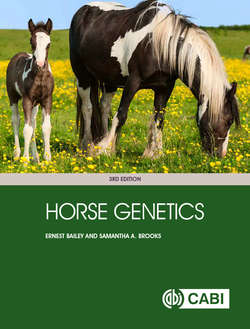Читать книгу Horse Genetics - Ernest Bailey - Страница 32
На сайте Литреса книга снята с продажи.
Horses
ОглавлениеThis group comprises two species, commonly known as Przewalski’s horse (E. przewaslkii) and the domestic horse (E. caballus). The domestic horse is well known and is the primary subject of this book. One likely ancestor of the horse, sometimes called a tarpan (E. ferus ferus and E. f. sylvestris), has become extinct in the wild but the natural distribution was throughout modern-day Europe, Asia, and the Middle East (Groves and Ryder, 2000). Przewalski’s horse (Fig. 3.4) is a closely related species that was driven to extinction in the wild during the 1900s, and then reintroduced to the Hustai National Park of Mongolia in 1992 using captive born Przewalski’s horses (Boyd and King, 2011). Before its initial extinction in the wild, the natural distribution of Przewalski’s horses appears to have been from eastern Germany through to the northern regions of Asia, especially Mongolia. The extant Przewalski’s horse population is descended from only 12 horses brought into zoo populations in the early 1900s. Today, the number of Przewalski’s horses exceeds 1800, including more than 300 living in the wild.
Fig. 3.4. Przewalski Horse (E. przewalskii) (picture provided by Zoological Society of San Diego).
The relationship between Przewalski’s horses and domestic horses continues to be a topic of research and discussion. Hybrids of the two species can be fertile, and indeed, are likely to have produced occasional hybrids that contributed to the genomic constitution of domestic horses (Gaunitz et al., 2018). Differences in overall genome organization are minimal. The most obvious difference is the number of chromosomes with E. caballus having 64 and E. przewalskii having 66. The difference appears to be the result of what is called a “Robertsonian translocation” when two smaller chromosomes fuse to form a single larger chromosome (Myka et al., 2003). Chromosome EPR23 of the E. przewalskii is homologous to the long arm of E. caballus chromosome ECA5. Chromosome EPR24 is homolgous to the short arm of ECA5. It appears that chromosome ECA5 of E. caballus is the product of an ancient, evolutionary fusion between two chromosomes in a species that is an ancestor of E. caballus and E. przewalskii (Myka et al., 2003). However, the mitochondrial genome and the Y chromosome of Przewalski’s horses and domestic horses are distinctly different, demonstrating that they are clearly different species (Oakenfull and Ryder, 1998; Oakenfull et al., 2000; Wallner et al., 2003; Lindgren et al., 2004; Lau et al., 2009).
